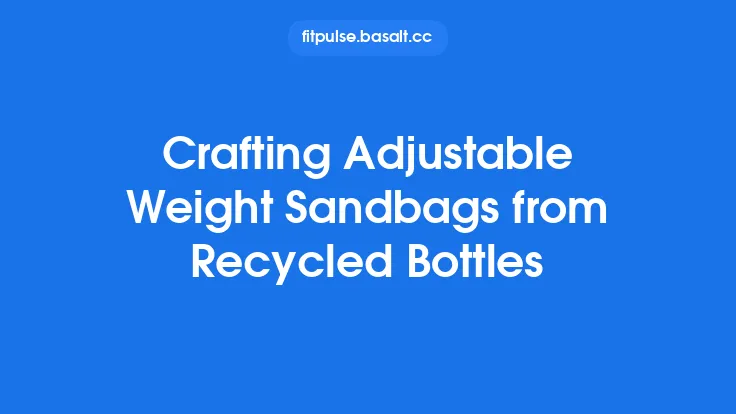When it comes to adding extra resistance to lower‑body movements without investing in expensive equipment, a pair of ankle weights made from everyday items can be a game‑changer. By repurposing sturdy water bottles and combining them with durable fabric, you can create adjustable, comfortable, and effective ankle weights that last for years. This guide walks you through every aspect of the project—from selecting the right bottles and fabrics, to stitching techniques, safety considerations, and ways to customize the load for different training goals. Whether you’re a beginner looking to boost the intensity of body‑weight exercises or an experienced athlete seeking a portable solution for travel, these DIY ankle weights provide a flexible, low‑cost alternative to commercial products.
Materials and Tools You’ll Need
| Item | Recommended Specs | Why It Matters |
|---|---|---|
| Water bottles | 1‑liter PET bottles with screw‑on caps (or 500 ml for lighter loads) | PET is strong, water‑tight, and easy to clean; the cap provides a convenient anchor point for the strap. |
| Fabric | 600‑800 D ripstop nylon, heavy‑weight canvas, or upholstery fabric (minimum 2 mm thickness) | High tensile strength prevents tearing under load; ripstop patterns resist propagation of small cuts. |
| Thread | UV‑resistant polyester or nylon thread, 100‑200 lb (45‑90 kg) tensile rating | Ensures seams hold up to repeated stretching and exposure to sweat. |
| Sewing needle | Heavy‑duty hand‑sewing needle (size 90/14 or larger) or a sewing machine capable of handling thick fabric | Facilitates strong, even stitches. |
| Fastening hardware | Adjustable hook‑and‑loop (Velcro) strips, or a quick‑release buckle system; optional metal D‑rings for extra security | Allows easy on/off and fine‑tuning of weight distribution. |
| Sealant (optional) | Food‑grade silicone or epoxy | Provides extra waterproofing for the bottle caps and seams. |
| Scissors / rotary cutter | Sharp, to avoid fraying fabric edges | Clean cuts improve seam integrity. |
| Measuring tape / ruler | Metric or imperial, accurate to 1 mm / 1/16 in | Critical for consistent strap length and placement. |
| Marker or fabric chalk | For layout lines | Prevents guesswork and ensures symmetry. |
Designing the Weight Envelope
1. Determining Bottle Placement
The most ergonomic position for the bottle is directly against the outer side of the ankle, just above the foot. This placement:
- Keeps the center of mass close to the limb, reducing torque that could cause the strap to slip.
- Allows the cap to sit against the fabric, providing a natural anchor point for the strap’s closure.
- Minimizes interference with the foot’s natural range of motion.
2. Calculating Load Capacity
A standard 1‑liter PET bottle filled with water weighs roughly 1 kg (2.2 lb). Adding the weight of the bottle itself (~30 g) and the fabric envelope (~50 g) brings the total to about 1.08 kg per ankle. If you need more resistance, you can:
- Use 2‑liter bottles (≈2 kg each).
- Fill bottles partially with sand, gravel, or small metal beads for finer weight increments.
- Stack two bottles side‑by‑side within a larger fabric pocket (requires a wider strap).
3. Sketching the Pattern
A simple rectangular pocket works best:
- Length: 12–15 cm (5–6 in) to accommodate the bottle’s height plus a 2 cm (0.8 in) seam allowance on each end.
- Width: 8–10 cm (3–4 in) to wrap comfortably around the ankle without digging into the skin.
- Flap: An additional 5 cm (2 in) extension on one side for the fastening system.
Create a paper prototype first, folding it around a bottle to verify fit before cutting fabric.
Step‑by‑Step Construction
Cutting the Fabric
- Lay the fabric flat on a clean surface.
- Measure and mark two identical rectangles using the dimensions above.
- Add a 1 cm (0.4 in) seam allowance around all edges; for the flap, extend the allowance to 2 cm (0.8 in) to accommodate the fastening hardware.
- Cut the pieces with sharp scissors or a rotary cutter.
Assembling the Pocket
- Pin the pieces together with the right sides facing each other (the side that will be visible when worn). Align the edges, leaving the flap edge open.
- Sew the long sides using a 3‑thread (triple) stitch for maximum strength. A 5 mm (¼ in) stitch length works well for heavy fabric.
- Reinforce the corners with a backstitch or a small square of fabric (a “stay”) to prevent tearing under tension.
- Turn the pocket right‑side out and press lightly with an iron (low heat) to flatten seams.
Installing the Fastening System
- Velcro Method:
- Sew a strip of hook‑type Velcro onto the inner side of the flap.
- Attach the loop‑type counterpart to the outer side of the pocket, opposite the flap.
- Ensure the Velcro overlaps by at least 3 cm (1.2 in) for a secure closure.
- Buckle Method (optional for quick release):
- Sew a small D‑ring onto the flap’s inner edge.
- Thread a nylon webbing strap through the D‑ring and secure it with a cam buckle.
- Adjust the strap length so the bottle sits snugly against the ankle without excessive slack.
Securing the Bottle
- Insert the water bottle into the pocket, cap side facing outward.
- If using a cap as an anchor, place a small piece of fabric or a rubber washer over the cap before closing the flap. This distributes pressure and prevents the cap from digging into the fabric.
- Close the flap using the chosen fastening method, ensuring the bottle is immobilized but the strap remains flexible enough to slide on/off the ankle.
Finishing Touches
- Waterproofing: Apply a thin bead of food‑grade silicone around the seam edges and the cap area. This prevents moisture from seeping into the fabric, which could weaken the thread over time.
- Labeling: Write the weight (e.g., “1 kg”) on the outer side of the pocket with a permanent marker. This helps you track load progression.
- Testing: Gently pull on the strap and shake the bottle to confirm there is no slippage. Perform a few squat or leg‑raise motions to feel for any discomfort.
Adjustability and Progressive Overload
One of the biggest advantages of this DIY design is the ability to fine‑tune resistance without buying new equipment. Here are three practical methods:
- Partial Filling: Fill a 1‑liter bottle with 500 ml of water and add 250 g of sand. This yields a custom weight (≈0.75 kg) that can be altered by adjusting the water‑sand ratio.
- Layered Bottles: For heavier training phases, slide a second bottle into a larger pocket (e.g., a 2‑liter bottle inside a 3‑liter pocket). Ensure the strap width accommodates the added bulk.
- Interchangeable Pockets: Sew a series of detachable pockets (using snap fasteners or zip ties) that can be swapped on a single strap. This lets you keep a single pair of ankle straps while varying the bottle size.
Safety Considerations
- Even Distribution: Always wear the weights on both ankles simultaneously to avoid creating an imbalance that could strain the hips, knees, or lower back.
- Secure Closure: Double‑check the fastening before each workout. A loose strap can cause the bottle to shift, leading to sudden torque on the ankle joint.
- Weight Limits: For beginners, start with 0.5–1 kg per ankle. Advanced athletes may progress to 2–3 kg, but avoid exceeding 5 kg per ankle unless you have a solid strength base and proper technique.
- Joint Health: Perform a brief warm‑up (e.g., ankle circles, calf raises) before adding weight. If you feel pain in the Achilles tendon, shin, or ankle joint, reduce the load or discontinue use.
- Material Integrity: Inspect the bottles for cracks or deformations regularly. PET can become brittle over time, especially if exposed to UV light or extreme temperatures.
Maintenance and Longevity
- Cleaning: Rinse the bottles after each use, especially if you’ve added sand or other non‑water fillers. Wipe the fabric pocket with a mild detergent and let it air‑dry completely before storage.
- Stitch Checks: Every few weeks, run a finger along each seam to feel for fraying or loosened threads. Reinforce any weak spots with a backstitch.
- Storage: Keep the ankle weights in a dry, cool place. Avoid leaving them in direct sunlight, which can degrade both PET and fabric over time.
- Replacement: If the fabric shows signs of wear (e.g., thinning, holes) or the bottle caps become difficult to close, replace the affected component rather than the entire set. The modular nature of the design makes swapping parts straightforward.
Practical Applications and Exercise Ideas
Lower‑Body Strength
- Standing Calf Raises: Perform 3 × 15–20 reps with the ankle weights to increase load on the gastrocnemius and soleus.
- Weighted Glute Bridges: Add ankle weight to keep the hips stable while focusing on hip extension.
- Lateral Leg Raises: Target the hip abductors and gluteus medius with controlled side‑lying movements.
Core and Stability
- Weighted Bird‑Dog: Place ankle weights while extending opposite arm and leg to intensify core stabilization.
- Plank Leg Lifts: Lift one leg at a time while maintaining a plank; the added weight challenges the anterior chain.
Cardio and Plyometrics
- High‑Knee Marches: Increase heart rate while strengthening hip flexors.
- Jump Rope: Use light ankle weights (≤0.5 kg) to add resistance without compromising joint safety.
Rehabilitation
- Ankle Dorsiflexion/Plantarflexion: Gentle resistance can aid in post‑injury strengthening when prescribed by a physiotherapist.
- Balance Drills: Perform single‑leg stands on a soft surface; the added weight improves proprioception.
Cost Breakdown (Approximate)
| Item | Quantity | Unit Cost | Total |
|---|---|---|---|
| 1‑liter PET bottle (reusable) | 2 | $0.30 | $0.60 |
| Heavy‑weight fabric (1 m²) | 0.2 m² | $8.00/m² | $1.60 |
| Polyester thread (spool) | 1 | $3.00 | $3.00 |
| Velcro strips (10 cm) | 2 | $0.50 | $1.00 |
| Optional silicone sealant | 1 tube | $4.00 | $4.00 |
| Total (excluding tools) | ≈ $10–$12 |
Even if you already own a sewing kit, the entire project can be completed for under $15, making it one of the most cost‑effective ways to add resistance to your lower‑body routine.
Customization Ideas
- Color Coding: Use different fabric colors for each ankle to quickly identify left vs. right during fast‑paced workouts.
- Reflective Tape: Add strips for visibility if you train outdoors at dawn or dusk.
- Integrated Pockets: Sew a small zippered pocket on the outer side of the strap to store a key or a tiny towel.
- Adjustable Length: Incorporate a sliding buckle (like those on backpack straps) to accommodate users of varying ankle circumferences.
Frequently Asked Questions
Q: Can I use soda bottles instead of water bottles?
A: Yes, as long as the bottle is made of sturdy PET and has a secure screw‑on cap. Soda bottles are often thicker, which can be an advantage, but ensure the cap threads are intact.
Q: Is it safe to fill the bottles with sand?
A: Sand provides a denser weight, allowing you to achieve higher loads with smaller bottles. However, sand can shift inside the bottle, causing an uneven center of mass. To mitigate this, fill the bottle partially with sand and top it off with water, or add a small piece of fabric inside to keep the sand settled.
Q: How do I prevent the strap from cutting into my skin?
A: Choose a fabric with a smooth finish and add a thin layer of padding (e.g., a folded piece of neoprene) along the inner edge of the strap. This distributes pressure and reduces friction.
Q: Will the water inside the bottle affect the weight if it freezes?
A: Freezing expands water, which could stress the bottle. Avoid using the ankle weights in sub‑zero environments unless you fill the bottles with a non‑freezing medium (e.g., sand or oil).
Q: Can I wash the entire ankle weight in a washing machine?
A: It’s best to hand‑wash the fabric pocket to preserve seam integrity. The bottle can be rinsed separately. If you must machine‑wash, place the pocket in a mesh laundry bag and use a gentle cycle.
Final Thoughts
Creating ankle weights from water bottles and fabric blends ingenuity with practicality. The result is a lightweight, adjustable, and portable tool that can seamlessly integrate into any home‑workout regimen. By following the detailed construction steps, respecting safety guidelines, and experimenting with load variations, you’ll have a reliable piece of equipment that grows with your fitness journey—without ever needing to step foot in a store. Happy building, and enjoy the added resistance!





